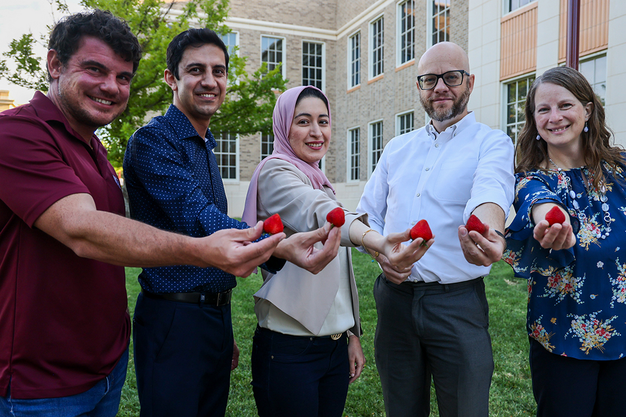West Texas A&M University researchers are leading a study on how to make strawberry production more feasible across Texas and the south-central United States after winning a federal grant.
The WT team—led by Dr. Nathan Howell, WT's Bell Professor of Engineering—won the $37,000 grant from the U.S. Department of Agriculture's Specialty Crop Research Initiative.
Now, the team is seeking input from those interested in growing strawberries in the area. Those interested can fill out a survey here.
Almost all strawberries are grown in areas of California and Florida where temperatures remain moderate throughout long portions of the year, Howell said. In Texas, strawberries have traditionally been grown in a shorter season, when temperatures don't generally rise above 80 degrees Fahrenheit or below freezing. They traditionally are grown in rows in raised soil beds, covered in plastic, and watered and fertilized through drip lines.
"Texas-based strawberry farmers can't grow their business predominately due to our climate," Howell said. "To increase their production capacity and begin to earn profits, farmers can either grow on more land or grow for longer periods of time."
Howell's team will gather information at several events for strawberry growers over the next year to determine the farmers' needs, learn about any possible barriers, and interrogate the farmers' attitudes about producing strawberries in controlled environmental settings.

"We're investigating whether there's a business model that makes sense in which large investments in building growing structures with indoor climate systems," Howell said. "We also want to see what kinds of issues with quality, disease, and pests the farmers might run into."
Potentially, the research could find ways to grow strawberries using far less water than is traditionally used with row crops, Howell said.
Following the year-long study, the team will seek funding for a larger grant that could explore ways to encourage Texas strawberry farmers to be pioneers in using these new methods.
Howell's cross-disciplinary team includes representatives from WT's College of Engineering and the Paul Engler College of Agriculture and Natural Sciences: Dr. Behnam Askarian, assistant professor of electrical engineering; Dr. Azi Tabei, assistant professor of electrical engineering and computer science; Dr. Bridget Guerrero, the Paul Engler Professor of Agriculture; and Dr. Colton Atkins, assistant professor of engineering/agriculture technology. Team members have expertise in horticulture, biology, environmental engineering, electrical engineering, computer science, agricultural technology, and agricultural economics.
The team also has worked with researchers with Texas A&M AgriLife Research and Extension Centers in Lubbock and Dallas, as well as others from Texas Tech University and Mississippi State University.
The WT grant was part of a $70.4 million investment announced in September by the USDA National Institute of Food and Agriculture. Other grants were given for projects studying avocado production, climate-resilient tomatoes, and more.
Meeting area needs as a Regional Research University is the primary goal of the University's long-range plan, WT 125: From the Panhandle to the World.
That plan is fueled by the historic One West comprehensive fundraising campaign, which reached its initial $125 million goal 18 months after publicly launching in September 2021. The campaign's new goal is to reach $175 million by 2025; currently, it has raised more than $160 million.
Source: West Texas A&M University
